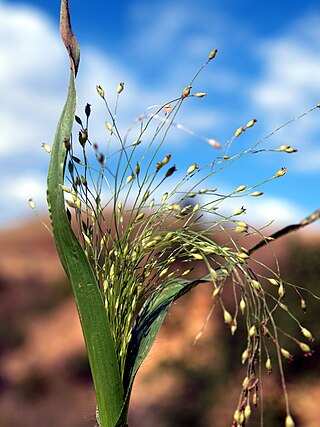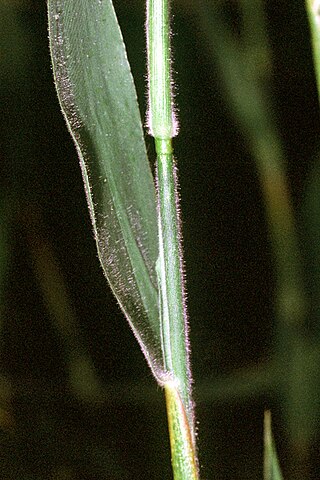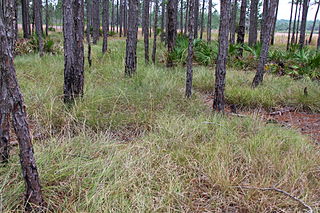
Panicum (panicgrass) is a large genus of about 450 species of Poaceae grasses native throughout the tropical regions of the world, with a few species extending into the northern temperate zone. They are often large, annual or perennial grasses, growing to 1–3 m (3–10 ft) tall.
Panicum mosaic virus (PMV) is a positive-sense single-stranded RNA viral pathogen that infects plant species in the panicoid tribe of the grass family, Poaceae. The pathogen was first identified in Kansas in 1953 and most commonly causes disease on select cultivars of turf grass, switchgrass, and millet. The disease most commonly associated with the panicum mosaic virus pathogen is St. Augustine Decline Syndrome, which infects species of turf grass and causes chlorotic mottling. In addition to St. Augustine Decline, panicum mosaic virus is responsible for chlorotic streaking and mild green mosaicking in select cultivars of switchgrass and millet.

Panicum turgidum is an old world clumping desert bunchgrass of the genus Panicum. It is a plant of arid regions across Africa and Asia, and has been introduced to other parts of the world.

Panicum capillare, known by the common name witchgrass, is a species of grass. It is a native plant to most of North America from the East Coast through all of the West Coast and California. It can be found as an introduced species in Eurasia, and as a weed in gardens and landscaped areas. It grows in many types of habitat.

Sacciolepis is a genus of plants in the grass family. Cupscale grass is a common name for plants in this genus.

Panicum dichotomiflorum, known by the common names fall panicgrass, autumn millet, and fall panicum is a species of Poaceae "true grass". It is native to much of the eastern United States and parts of Canada, and it can be found in the Western United States through California. It may be an introduced species in some western climates. It grows in many types of habitat, including disturbed areas and chaparral habitats.

Panicum hirticaule is a species of grass known by the common names Mexican panicgrass and roughstalked witchgrass. It is also known as the Sonoran millet, and is cultivated as a cereal crop in the American Southwest.

Panicum urvilleanum is a species of grass known by the common names desert panicgrass and silky panicgrass. It is native to the southwestern United States and northern Mexico, where it grows in sandy habitat, including the dunes of the deserts. It is also known in parts of South America.

Sporobolus cryptandrus is a species of grass known as sand dropseed. It is native to North America, where it is widespread in southern Canada, most of the United States, and northern Mexico.

Panicum niihauense is a rare species of grass known by the common names lau 'ehu and Niihau panicgrass. It is endemic to Hawaii, where it has been found on the islands of Niihau and Kauai. It has not been observed on Niihau since 1949, and there are fewer than 40 individuals remaining on Kauai, not counting a few individuals that have been deliberately planted in appropriate habitat. The grass is a federally listed endangered species of the United States.

Calamovilfa longifolia is a species of grass known by the common names prairie sandreed and sand reedgrass. It is native to North America, where it occurs from the Northwest Territories to Ontario in Canada and as far south as New Mexico and Kansas in the United States. There are two varieties, var. longifolia being widespread in the species' range and var. magna being native to the Great Lakes region.

Panicum hemitomon is a species of grass known by the common name maidencane. It is native to North America, where it occurs along the southeastern coastline from New Jersey to Texas. It is also present in South America.

Panicum repens is a species of grass known by many common names, including torpedo grass, creeping panic, panic rampant, couch panicum, wainaku grass, quack grass, dog-tooth grass, and bullet grass. Its exact native range is obscure. Sources suggest that the grass is native to "Africa and/or Asia", "Europe or Australia", "Eurasia", "Australia", "Europe, Asia, and Africa", or other specific regions, including the Mediterranean, Israel, and Argentina. It is present in many places as an introduced species and often a noxious weed. It has been called "one of the world's worst weeds."

Amphicarpum muehlenbergianum is a species of grass known by the common names blue maidencane, Muhlenberg maidencane, and goobergrass. It is native to the southeastern United States.

Dichanthelium scoparium is a species of grass known by the common names velvet panicum, velvety panicgrass, and broom panicgrass. It is native to North America, where it occurs in the southeastern United States. It also occurs in the West Indies.

Panicum abscissum is a species of grass known by the common name cutthroat grass. It is endemic to Florida in the United States. It is limited to five counties in the central Florida peninsula.

Panicum amarum is a species of grass known by the common name bitter panicum. It is native to North America, where it is found in coastal regions along the East Coast and Gulf Coast of the United States and into northeastern Mexico. It also occurs in The Bahamas and in Cuba.

Panicum anceps is a species of grass known by the common name beaked panicgrass. It is native to the southeastern United States, where it occurs as far north as New Jersey and as far west as Kansas and Texas.

Panicum coloratum is a species of grass known by the common names kleingrass, blue panicgrass (USA), white buffalograss ; Bambatsi panic, makarikari grass, and coolah grass (Australia). It is native to Africa, and it has been introduced elsewhere, such as the United States and Australia, and bred into many cultivars.

Panicum flexile, commonly called wiry panicgrass, is a species of flowering plant in the grass family (Poaceae). It is primarily native to eastern to North America, where it has a scattered and localized distribution. It is typically found in mafic or calcareous open areas, both wet and dry, particularly associated with limestone.




















